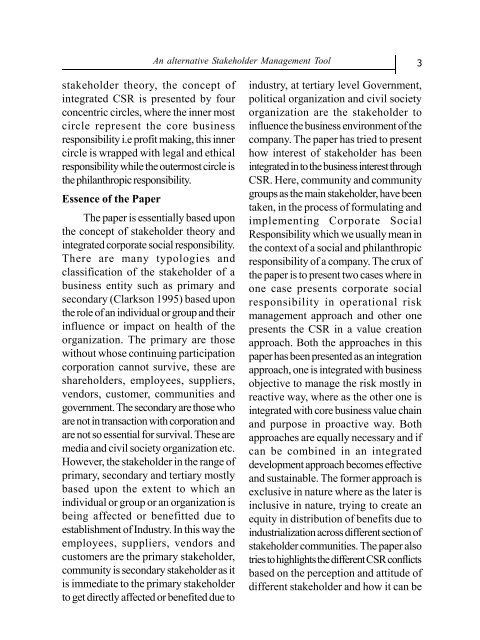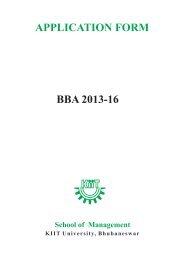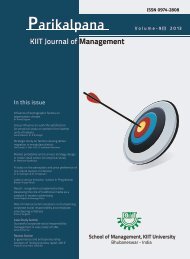Download - School of Management, KIIT University
Download - School of Management, KIIT University
Download - School of Management, KIIT University
You also want an ePaper? Increase the reach of your titles
YUMPU automatically turns print PDFs into web optimized ePapers that Google loves.
An alternative Stakeholder <strong>Management</strong> Tool<br />
3<br />
stakeholder theory, the concept <strong>of</strong><br />
integrated CSR is presented by four<br />
concentric circles, where the inner most<br />
circle represent the core business<br />
responsibility i.e pr<strong>of</strong>it making, this inner<br />
circle is wrapped with legal and ethical<br />
responsibility while the outermost circle is<br />
the philanthropic responsibility.<br />
Essence <strong>of</strong> the Paper<br />
The paper is essentially based upon<br />
the concept <strong>of</strong> stakeholder theory and<br />
integrated corporate social responsibility.<br />
There are many typologies and<br />
classification <strong>of</strong> the stakeholder <strong>of</strong> a<br />
business entity such as primary and<br />
secondary (Clarkson 1995) based upon<br />
the role <strong>of</strong> an individual or group and their<br />
influence or impact on health <strong>of</strong> the<br />
organization. The primary are those<br />
without whose continuing participation<br />
corporation cannot survive, these are<br />
shareholders, employees, suppliers,<br />
vendors, customer, communities and<br />
government. The secondary are those who<br />
are not in transaction with corporation and<br />
are not so essential for survival. These are<br />
media and civil society organization etc.<br />
However, the stakeholder in the range <strong>of</strong><br />
primary, secondary and tertiary mostly<br />
based upon the extent to which an<br />
individual or group or an organization is<br />
being affected or benefitted due to<br />
establishment <strong>of</strong> Industry. In this way the<br />
employees, suppliers, vendors and<br />
customers are the primary stakeholder,<br />
community is secondary stakeholder as it<br />
is immediate to the primary stakeholder<br />
to get directly affected or benefited due to<br />
industry, at tertiary level Government,<br />
political organization and civil society<br />
organization are the stakeholder to<br />
influence the business environment <strong>of</strong> the<br />
company. The paper has tried to present<br />
how interest <strong>of</strong> stakeholder has been<br />
integrated in to the business interest through<br />
CSR. Here, community and community<br />
groups as the main stakeholder, have been<br />
taken, in the process <strong>of</strong> formulating and<br />
implementing Corporate Social<br />
Responsibility which we usually mean in<br />
the context <strong>of</strong> a social and philanthropic<br />
responsibility <strong>of</strong> a company. The crux <strong>of</strong><br />
the paper is to present two cases where in<br />
one case presents corporate social<br />
responsibility in operational risk<br />
management approach and other one<br />
presents the CSR in a value creation<br />
approach. Both the approaches in this<br />
paper has been presented as an integration<br />
approach, one is integrated with business<br />
objective to manage the risk mostly in<br />
reactive way, where as the other one is<br />
integrated with core business value chain<br />
and purpose in proactive way. Both<br />
approaches are equally necessary and if<br />
can be combined in an integrated<br />
development approach becomes effective<br />
and sustainable. The former approach is<br />
exclusive in nature where as the later is<br />
inclusive in nature, trying to create an<br />
equity in distribution <strong>of</strong> benefits due to<br />
industrialization across different section <strong>of</strong><br />
stakeholder communities. The paper also<br />
tries to highlights the different CSR conflicts<br />
based on the perception and attitude <strong>of</strong><br />
different stakeholder and how it can be







